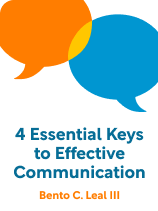

This article is an excerpt from the Shortform book guide to "4 Essential Keys to Effective Communication" by Bento C. Leal III. Shortform has the world's best summaries and analyses of books you should be reading.
Like this article? Sign up for a free trial here.
Why should you think before you speak? What steps should you take to get your thoughts organized?
Thinking before you speak allows you to sort out how you’re feeling. Bento C. Leal’s book 4 Effective Keys to Effective Communication says this is crucial because you don’t want strong emotions controlling the conversation.
Read on to learn how to think before you speak.
Get Organized
Leal recommends learning how to think before you speak to sort out what you’re thinking, how you’re feeling, and what you want to get from the conversation. When we speak before clarifying these factors, our strong emotions might make us confused about what we really want and cause us to act dramatically, possibly saying things that are hurtful or that we don’t really mean. Acting in this way will make the other person unreceptive to what we’re saying and will likely produce an unsatisfactory end to the conversation. In contrast, planning helps us to express exactly what we need the other person to hear in a way that’s easy for them to understand and that triggers productive conversation.
For example, if your partner upsets you, your strong emotions might flood you with the urge for revenge when rationally, you want to solve the problem and achieve peace. If you don’t take a second to plan your response, these emotions might cause you to accuse or yell at your partner rather than speaking to them with empathy, triggering a major fight. If you’d taken a second to plan your response before speaking, you could have avoided this.
Separate Observations From Evaluations and Feelings From Judgments
In Nonviolent Communication, Rosenberg agrees that it’s crucial to stop and organize your thoughts and feelings before speaking. However, he breaks this process into two steps and provides additional advice that might make Leal’s easier to follow.
Rosenberg’s first step for organizing your thoughts is to observe your feelings without using them to make evaluations of the other person. For example, “I feel frustrated” is an observation of your feelings. Meanwhile, “you’re an annoying person” is an evaluation of the person who caused your feelings, but it’s not an objective fact. It’s important to separate these thoughts and avoid making (and communicating) evaluations because they lead to moralistic judgments—a form of life-alienating communication discussed in our earlier commentary. Further, this step will help you clearly distinguish between your feelings, your thoughts, and reality.
Rosenberg’s second step for organizing your thoughts is to accurately identify your emotions and their causes—in particular, to clearly distinguish emotions from thoughts. While the word “feel” should be used to describe your emotions, many people use “feel” to describe what they’re thinking. For example, you don’t “feel like this is a bad idea”—you “feel uncomfortable because you think this is a bad idea.” Once you’ve identified what you’re truly feeling (as opposed to just thinking), try to understand why you’re feeling that way. For example, maybe you feel uncomfortable with the idea because you’re afraid that it’s going to get you in trouble.
This second step will help you clearly explain yourself to the other person. Realizing why you feel the way you do will also help you to avoid forms of life-alienating communication such as denial of responsibility: You’ll know if you’re the reason why you feel the way you do. Finally, this process as a whole will ensure that the conversation reaches a satisfying conclusion for all parties involved.

———End of Preview———
Like what you just read? Read the rest of the world's best book summary and analysis of Bento C. Leal III's "4 Essential Keys to Effective Communication" at Shortform.
Here's what you'll find in our full 4 Essential Keys to Effective Communication summary:
- How to avoid the two most damaging communication faux pas
- How to listen and express yourself with empathy
- Why having empathy for others starts with seeing the worth in yourself






